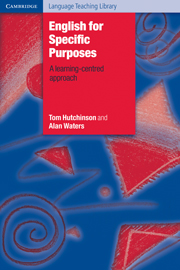3 - ESP: approach not product
Published online by Cambridge University Press: 03 May 2010
Summary
Beware that you do not lose the substance by grasping at the shadow.
(Aesop: ‘The Fable of the Dog and the Shadow’)The survey above shows that in its relatively brief history there have been several major shifts in the development of ESP both in theory and practice. However, we have tried to show that, in spite of their differences, the successive stages have all concentrated on the linguistic aspect of ESP: they are all essentially language-centred approaches. In later chapters we shall look in greater detail at how this has shaped the way in which people see ESP. For now let us return to the question posed at the beginning of this section: ‘What is ESP?’ To answer this question fully, we need first of all to establish a context which will help us to see how ESP at the present time relates to the rest of ELT. What exactly is the status of the citizens of ESP and its satellite settlements in relation to the general world of ELT?
In the time-honoured manner of linguistics, we shall represent the relationship in the form of a tree (see figure 3).
The tree represents some of the common divisions that are made in ELT. The topmost branches of the tree show the level at which individual ESP courses occur. The branches just below this level indicate that these may conveniently be divided into two main types of ESP differentiated according to whether the learner requires English for academic study (EAP: English for Academic Purposes) or for work/ training (EOP/EVP/VESL: English for Occupational Purposes/English for Vocational Purposes/Vocational English as a Second Language).
- Type
- Chapter
- Information
- English for Specific Purposes , pp. 16 - 20Publisher: Cambridge University PressPrint publication year: 1987
- 2
- Cited by



